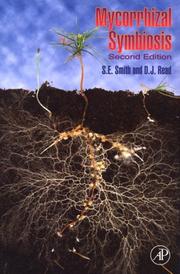| Listing 1 - 3 of 3 |
Sort by
|

ISBN: 0126528403 9786611984137 1281984132 0080537197 9780126528404 9780080537191 Year: 2002 Publisher: San Diego : Academic Press,
Abstract | Keywords | Export | Availability | Bookmark
 Loading...
Loading...Choose an application
- Reference Manager
- EndNote
- RefWorks (Direct export to RefWorks)
In nature, the roots of most plants are colonized by symbiotic fungi to form mycorrhiza, which play a critical role in the capture of nutrients from the soil, and therefore in plant nutrition. Thirteen years have passed since the publication of the First Edition of Mycorrhizal Symbiosis, the book that has been generally acclaimed as the most definitive work on this fascinating topic. The Second Edition co-authored by Professor Sally Smith and Professor David Read has been completely rewritten to cover the significant advances in our understanding of this field.Key Features*
Mycorhizé --- Mycorrhizae --- Mycorhizé à vésicule et arbuscule --- Vesicular arbuscular mycorrhizae --- Symbiose --- Symbiosis --- Nutrition des plantes --- plant nutrition --- Orchidaceae --- Ericaceae --- Propriété physicochimique du sol --- soil chemicophysical properties --- Écosystème --- ecosystems --- Développement biologique --- biological development --- Mycorrhizas --- 582.28 --- Mycorrhiza --- 581.557.24 --- Mycorhiza --- Mycorhizas --- Roots (Botany) --- Mycorrhizas. --- 581.557.24 Mycorrhiza --- Symbiosis. --- Mycorrhizal symbiosis --- Consortism --- Biology --- Symbiogenesis --- Monograph
Book
Year: 2020 Publisher: Basel, Switzerland MDPI - Multidisciplinary Digital Publishing Institute
Abstract | Keywords | Export | Availability | Bookmark
 Loading...
Loading...Choose an application
- Reference Manager
- EndNote
- RefWorks (Direct export to RefWorks)
In horticulture, plant propagation plays an important role, as the number of plants can be rapidly multiplied, retaining the desirable characteristics of the mother plants, and shortening the bearing age of plants. There are two primary forms of plant propagation: sexual and asexual. In nature, the propagation of plants most often involves sexual reproduction, and this form is still used in several species. Over the years, horticulturists have developed asexual propagation methods that use vegetative plant parts. Innovation in plant propagation has supported breeding programs and allowed the production of high quality nursery plants with the same genetic characteristics of the mother plant, free of diseases or pests.
Carya illinoinensis --- orchards --- seedlings production --- emergence rate --- Ericaceae --- Vaccinium virgatum --- micropropagation --- in vitro culture --- cytokinins --- zeatin --- 2iP --- BAP --- kinetin --- WPM --- clone aging --- foundation-stock --- genetic-disorder --- non-infectious --- epigenetic --- pepper --- propagation --- domestic --- wild --- protocorm-like bodies --- light-emitting diode --- trehalose --- maltose --- CCC --- correlation --- growth retardants --- rooting --- cutting --- forcing --- oleander --- shading --- acclimatization --- auxins --- Dracaena draco --- in vitro --- auxin --- rhizobacteria --- Vaccinium spp. --- bacterial wilt --- Solanum melongena --- susceptible --- tolerance --- exopolysaccharides --- cell wall degrading enzymes --- nursery plants --- plant multiplication --- seeds --- cuttings --- budding --- grafting --- biotechnology
Book
ISBN: 3039213105 3039213091 9783039213108 Year: 2019 Publisher: Basel, Switzerland : MDPI,
Abstract | Keywords | Export | Availability | Bookmark
 Loading...
Loading...Choose an application
- Reference Manager
- EndNote
- RefWorks (Direct export to RefWorks)
What are the causes and consequences of species diversity in forested ecosystems, and how is this species diversity being affected by rapid environmental and climatic change, movement of invertebrate and vertebrate herbivores into new biogeographic regions, and expanding human populations and associated shifts in land-use patterns? In this book, we explore these questions for assemblages of forest trees, shrubs, and understory herbs at spatial scales ranging from small plots to large forest dynamics plots, at temporal scales ranging from seasons to centuries, in both temperate and tropical regions, and across rural-to-urban gradients in land use.
gamma diversity --- tree species --- Climatic change --- individual species-area relationship --- woody species --- TILD --- trees --- Pseudotsuga menziesii --- windthrow --- precipitation --- species conservation --- spatial analysis --- codispersion analysis --- variation partitioning --- herbaceous perennial species --- northern hardwood forests --- climate change --- stand development --- potential habitats --- Smithsonian ForestGEO --- tree regeneration --- forest conversion --- Biodiversity Exploratories --- trunk breakage --- topography --- questionnaire survey --- mid-domain effect --- assemblage lineage diversity --- Salicaceae --- salvaging --- temperate forests --- Shannon diversity --- USDA Forest Service --- tree species diversity --- Bray-Curtis --- species-area relationship --- Ericaceae --- legacies --- Picea abies --- herbaceous layer --- spatial patterns --- mountains --- United States --- wind damage --- abundance --- Hubbard Brook --- elevational shifts --- uprooting --- species diversity --- evolutionary diversity --- Pinus sylvestris --- natural disturbance-based silviculture --- Vietnam --- diversity --- Maxent --- human footprint --- productivity --- China --- microarthropod --- phylogenetic diversity --- temperature --- household respondents --- succession --- biodiversity --- tornado --- salvage logging --- excess nitrogen --- climate --- forest management --- understory plant communities --- Simpson diversity --- species richness --- landscape scale --- structural complexity --- tropical evergreen mixed forest --- seasonal variations --- disturbance severity --- competition and facilitation --- canopy structure --- Fagus sylvatica
| Listing 1 - 3 of 3 |
Sort by
|

 Search
Search Feedback
Feedback About UniCat
About UniCat  Help
Help News
News